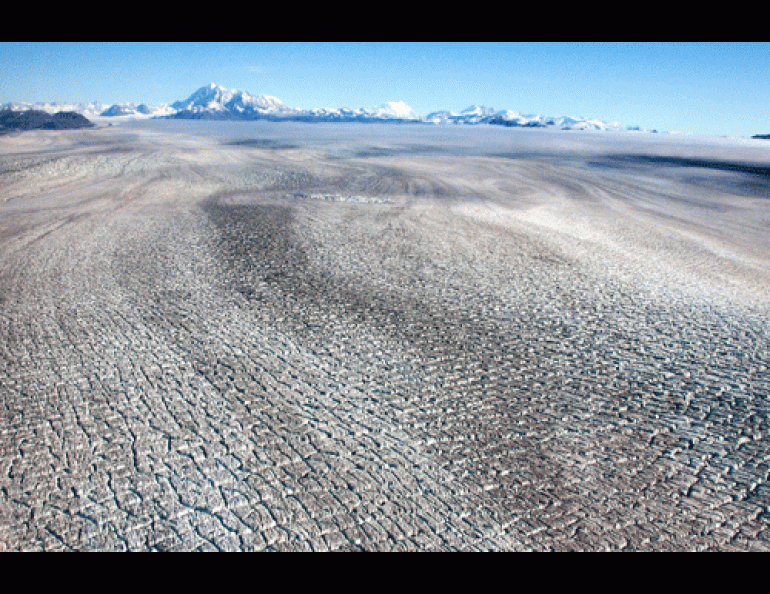
Alaska's largest glacier surging again
“What in the world is Bering doing?” a woman said when she looked at Chris Larsen’s photograph of the buckled back of Alaska’s largest glacier.
“The cracking-up is new on the glacier,” Larsen said. “There’s a lot more crevasses, and a lot more elevation increases where there should be thinning.”
The 2,000-square mile mass of Bering Glacier appears to be surging, Larsen told Geophysicist Jeanne Sauber of Goddard Space Flight Facility, who was looking at his poster in mid-December 2009, at the San Francisco meeting of the American Geophysical Union.
Larsen and colleagues discovered the surge—the sudden advance of part of the glacier—by checking the results of elevation-determining flights over the glacier in August and early September 2009.
“Where Bering takes a left out of the mountains, it’s about 100 meters higher than it was in August 2008,” said Larsen, who works at the University of Alaska Fairbanks’ Geophysical Institute.
When a glacier like Bering or Black Rapids surges, it’s usually not growing. Instead, a section has suddenly started moving, in this case a large portion upstream of where Bering calves icebergs into Vitus Lake, in the glorious country between Yakutat and Cordova.
“It’s like a slow-motion landslide,” Larsen said of the surge. “It’s taking material at one end and putting it in another . . . Some areas are quite crevassed, some not.”
In a strange occurrence, the glacier hasn’t yet expressed the movement of the surge at its terminus at Vitus Lake. When the glacier last surged in 1993 through 1995, pilots noticed it because the glacier shoved itself out into the lake, fracturing the ice on its surface. The recent movement has rumpled the ice miles upstream from where the glacier meets brackish water. Larsen said the surge hasn’t made its way to the terminus yet.
The largest mountain glacier in North America has surprised glaciologists with this recent activity. The surging may be spurred by clogs in the glacier’s drainage system located beneath it, allowing the glacier to float on slippery mud and wet rocks pushed oceanward by gravity. As scientists were realizing Bering’s last surge in 1993—when the glacier advanced at 50 feet per day, speeding up from its normal one foot per day—they figured they’d never see it again.
“There isn’t going to be anything like this probably for the rest of our careers,” U.S. Geological Survey Glaciologist Dennis Trabant told John Balzar of the L.A. Times in a January 1994 article.
Scientists figured a huge glacier like Bering might surge every 20 years or so; 14 years have passed since Bering last got up and went.
“Last time it surged for three years with an extra burst at the end,” Larsen said.
Larsen and other scientists will keep an eye on Bering to see if its surge forces the glacier’s tongue into Vitus Lake in 2010. Regardless of its motion, the giant river of ice will continue to shrink overall, pumping staggering amounts of freshwater into the ocean. Scientists announced in 2008 that Bering Glacier released about twice as much water into the ocean each year as is contained in the entire Colorado River.
Image caption cont: The whitish mountain in the far background is Mount Saint Elias. Photo by Chris Larsen.





